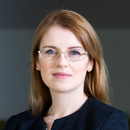Here we introduce Professor Mareike Zink from the Peter Debye Institute for Soft Matter Physics at our faculty. You will find information about her career, research and teaching, as well as an advice she would give herself as a student.

Do what you enjoy, hold on, when things seem difficult and stand up for yourself.
Prof Dr Mareike Zink
Career
- 2006: Completion of Studies
Physics, Diplom
Georg-August-Universität Göttingen with stays abroad at the University of Cambridge, UK and the California Institute of Technology (Caltech), USA
Thesis: “Mikroskopisches und makroskopisches Verhalten von CuTi Glas beim Scheren – Eine Simulationsstudie” - 2009: Doctorate
Dr rer nat, Biophysics
Max Planck Institute for Biophysical Chemistry, Department for Theoretical and Computational Biophysics
Topic: “Mechanical properties of icosahedral viral shells” - 2009–2013: Postdoc, Researcher
Universität Leipzig with several research stays at the University of Cambridge, UK - 2012: Acquisition and Head of an Independent Research Group
Universität Leipzig, Centre for Biotechnology and Biomedicine (BBZ) - since 2013: Head of the Group Biotechnology and Biomedicine
Universität Leipzig, Peter Debye Institute for Soft Matter Physics - Habilitation Equivalent
Instead of pursuing a habilitation, I quickly started to work independently, heading an independent research group for junior researchers already three years after completing my PhD. My accomplishments as junior group leader were recognised to be equivalent to a habilitation. - since 2017: Adjunct Professor
Universität Leipzig, Peter Debye Institute for Soft Matter Physics
Research
The research of my group “Biotechnology and Biomedicine” focusses on understanding the physics of cells and tissues. We investigate the organisation of brain cells, such as neurons and glia cells, on different materials outside of the body, the structures they build and how cellular structures can be quantified with physical methods.
The aim of this research is not only to characterise novel biomaterials for medical purposes, but also to pave new ways in reducing or replacing animal experiments in medical studies. As an example, the group uses eye tissues from slaughterhouse waste to study the mechanical properties of the retina for a better understanding of eye diseases.
Additionally, we investigate the elasticity of tissues, such as fetal lungs, to develop new therapies, e.g. for mechanical ventilation, based on a better understanding of their physical properties. To that end, we collaborate with different groups in the fields of physics, medicine and biology.
For our studies we use different microscopy techniques and force-spectroscopy-methods, but also in-house developed experimental equipment, to quantify tissue mechanics and cell–surface-interactions with physical properties like adhesion forces and to correlate them with biological properties such as tissue structure and tissue function.